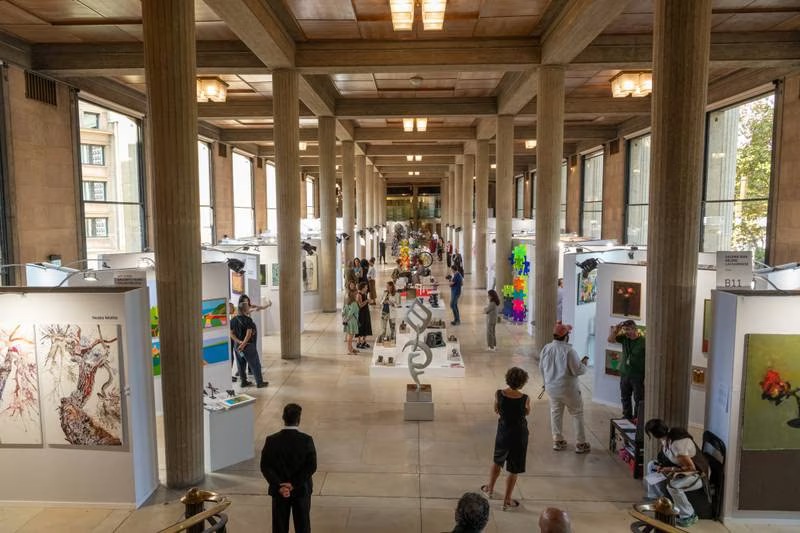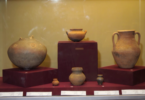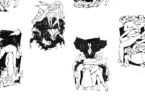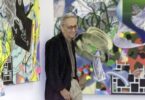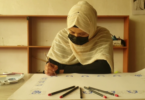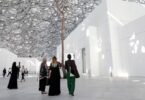Maghie Ghali
PARIS : This week, Paris is abuzz with Arab art and design, as creatives and galleries from the Middle East and North Africa once again gather in the French capital for the fourth edition of Menart Fair, the only European showcase dedicated to contemporary art from the Mena region.
Running until Sunday, the fair has expanded this edition with a larger offering of design galleries – with more than 30 from 11 countries – as well as music and dance performances and a wider off-site programme.
This year’s event also includes works from six art foundations and international institutions for the first time, with outlets such as Dubai’s Farjam Foundation and Afkhami Foundation, Paris’s Le Cercle de l’Art and Marrakesh’s Montresso Art Foundation taking part.
Hosted at the Palais d’Iena, a historic 20th-century building and the headquarters of the Economic, Social and Environmental Council, Menart’s scenography echoes the geometric window pattern of squares and triangles in the gallery displays.
:quality(70)/cloudfront-eu-central-1.images.arcpublishing.com/thenational/ARBH5S62PVECDMBE2LW7FJY43Q.jpg)
“This year, our main pillars are liberty, equality and fraternity, because here there is no censorship and because we’re bridging the gap between east and west – [we have] Mena artists showing in Paris, but also French galleries now showing Arab art – so the message is peace, love and the respect for each other,” Menart founder and director Laure d’Hauteville says.
“We’ve recently noticed that a growing number of French and European galleries are including artists from the Middle East. At Menart Fair, a third of our galleries this year are French.
“Some major museums in France and Europe have opened Mena departments in their ‘society of friends’. Auction houses are following the craze for these regions and since 2021 have been organising more and more dedicated sales,” she adds. “Institutions are preparing exhibitions on artists from the Mena for 2024.”
Despite the economic difficulties that Lebanon is going through, another third of the galleries are Lebanese, with well-known spaces like Saleh Barakat, Art on 56th and Galerie Tanit showcasing alongside more underground platforms like Young Collectors Sale.
:quality(70)/cloudfront-eu-central-1.images.arcpublishing.com/thenational/A5VC2G7H6ZDIFA6FM23AJAYN6M.jpg)
Eight galleries are focused on design, and the experimental Cairo gallery Le Lab is among them, showcasing Lebanese design duo T Sakhi – sisters Tessa and Tara Sakhi – with their latest series Jurat, comprised of Murano sculptural vessels, created using metal waste infused with glass.
The archaically shaped vases evoke relics of ancient Middle Eastern heritage, but are created with modern and novel techniques, seeking to bridge past and present, as well as east and west.
“My sister and I moved to Venice three years ago for a project,” Tara Sakhi tells The National. “We used to recuperate metal waste from factories around the Murano glass factories, and we would mix and do tests, changing temperature calibration, different timings in the process and seeing how different surfaces will emerge.
“What you see on the glass is aluminium mixed with brass powder and the process of work is the glassblower is creating the shape we predefined, and then Tessa and I were throwing in all the metal waste at different timings, so it’s a very organic process,” she adds.
“All the storytelling of glassmaking is linked between Egypt, Lebanon, North Syria – where glass was first discovered – and Venice, with their expertise of craftsmanship in glass, brought to them by the Silk Road.”
:quality(70)/cloudfront-eu-central-1.images.arcpublishing.com/thenational/U43MNDKE2FBVJCS4YTP2DKOMIM.jpg)
At night, the vessels are lit from below or within, casting stunning shadow patterns and refracted light through the peeling, patchy texture of the metal powder coating the glass, which come in smoky, white or purple.
Iranian designer Roham Shamekh, who lives in Dubai, unveiled his ceramic project The Fruit of Love at the fair, presented in a special installation. He presented Vase of Humanity – a large traditionally-shaped vase decorated with bright, hand-painted patterns inspired by Asian porcelain decorating – alongside a collection of candlesticks shaped into pink and green fruit-flowers, arrayed around the vase. Many visitors stopped to look at the detailed craftsmanship and colourful designs.
“Clay that we use to make ceramics comes from very dry earth and it’s only through human nurturing and love that life is able to grow from it and for flowers or fruit to emerge,” Shamekh tells The National. “I wanted to connect tradition and modernism together – by taking this very traditional vase form but using very modern colours – to think about the future, where care and love are essential for life.”
The arrayed flower candlesticks look like they’re sprouting from the ground due to the wellspring that the huge vase represents.
:quality(70)/cloudfront-eu-central-1.images.arcpublishing.com/thenational/ZRGWCRGKPRANNI7AV6ZVPTSJOY.jpg)
In the art section, newly opened Dubai gallery Nika Project Space is spotlighting Sharjah artist Fatma Al Ali’s archive-based contemporary work The Arabian Department, which digs into the erasure of culture, all centred on the humble carrot.
“This work dwells on the topic of westernisation and the practices of the British Empire, which was present in the region for 150 years,” Nika founder Veronika Berezina explains.
“During the study of archival materials, [Al Ali] found a very interesting document about the British demanding that people change from using the purple carrot, which was native to the region, to the more European type, the orange carrot.
“It was written in the document that it’s ‘far more superior’ and has a nice colour and smoother shape, so this is the type of carrot we should use in the region. People stopped growing the purple carrot and now it’s impossible to find locally.”
The works feature several “official documents” recreated from the originals and headed with a modified British stamp. Next to them sits a massive stamp seal, representing the weight of authority. The pieces may look simple, but carry a depth of meaning.
:quality(70)/cloudfront-eu-central-1.images.arcpublishing.com/thenational/SO64S5ENP5HUVHV6ZLFWWWAVNA.jpg)
“These works are made using purple carrot ink and they will fade away with time, intended as a very beautiful metaphor of the memory of something fading away with time as well,” Ms Berezina adds.
“She amended the documents with a modified stamp of the British Empire, replacing the two unicorns with the two carrots – a playful way to speak about a very serious topic of erasure of memory and culture.”
Other intriguing works include a series of emotive rose paintings by Azerbaijani artist Niyaz Najafov, under Paris’s Galerie Dix9 Helene Lacharmoise, which takes the novice idea of painting flowers and tries to push its boundaries.
From Najafov’s beginnings as a self-taught artist, painting flowers was a starting point that developed into a whole career, which saw him represent Azerbaijan at the 2009 Venice Art Biennale. By removing the importance of the painting’s subject, he instead chooses to focus on technique, painting over thousands of Absheron roses in various ways, on salvaged card.
“Many people consider flowers a very basic and easy subject in art – but I was interested in taking something basic and pushing it further, working on techniques, approaching painting as a research in pictorality,” Najafov says. “I’ve done more than 5,000 flower paintings and, from them, I’ve put on the walls of Paris more than 3,500 flowers. I like to walk around the city with some glue and a finished painting and just stick it wherever I find suits it. I have been doing this since 2015.”
Leaving Menart Fair to walk the streets of Paris, visitors might just spot some of these rose paintings around the city, if they keep their eyes peeled.
Courtesy: thenationalnews

